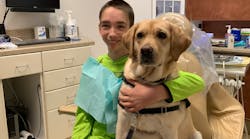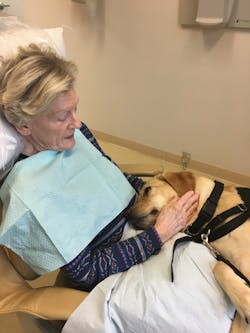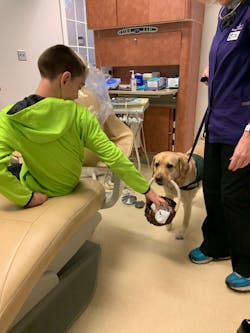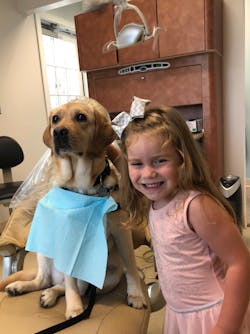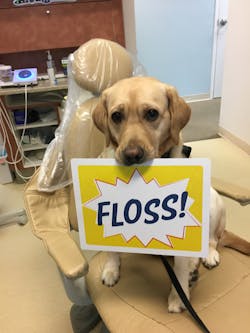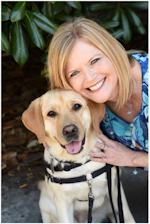Animal-assisted intervention: How facility dogs mitigate dental anxiety
I hate coming to the dentist! How many times have you heard this statement? I think I’ve heard it at least once a day since I started practicing dental hygiene. Statistics show that approximately eight out of 10 patients who walk through the door of a dental office have some degree of dental anxiety. It is estimated that 30–40 million Americans (15%) have dental phobia, an intense fear of the dentist that results in avoidance of dental appointments entirely.1,2 Patients with dental phobia only schedule and keep appointments when their dental pain is so unbearable that they have no other option. These are patients we only see in the office when they have a dental emergency.
I applied for a rehabilitative facility dog (facility dog, for short) with paws4people, and after a long application process, I was assigned my facility dog, Atkins. Atkins is a beautiful, yellow Labrador retriever who was two years old when we began our journey as a facility dog team in 2018. She has been trained since birth and is specifically trained to work in a dental office. To certify as a paws4people rehabilitative facility dog, Atkins completed 600 hours of training inclusive of puppy development, socialization and confidence, advanced obedience, and public access, plus more than 50 hours of facility dog training. As
Atkins’ primary handler in the dental office, I was required to train for 50 hours with her during the facility dog portion of her training.6 I often say that she trained me, along with the help of some highly skilled and knowledgeable paws4people trainers.
AAI in the dental practice
Both adult and pediatric patients benefit from animal-assisted intervention in a dental setting. Atkins has assisted with several adult patients who suffered from dental phobia and had not received dental treatment in years. These patientsAtkins assists with new-patient exams, dental hygiene appointments, and restorative appointments, enabling full treatment plans to be completed. Anxious patients began to schedule for preventive care for the first time in their lives. Atkins has assisted with patients who have dental anxiety but come to the dentist on a regular basis as well as with patients who simply love dogs; AAI makes their dental visits more enjoyable.
Prior to animal-assisted intervention, the patient or parent of the patient signs a release form. During AAI, Atkins, if requested by the patient, can provide deep pressure therapy. The weight of Atkins provides the same benefits of a weighted blanket, which is believed to relax highly anxious patients.7 This pressure therapy is achieved when she is positioned in the chair, on the patient’s lap, during the dental procedure. If patients prefer not to have her in the chair, on their lap, she can also be positioned on a bench next to and level with the dental chair. This enables the patient to pet her and keep in physical contact with her during the appointment. AAI, in general, is proven to lower the heart rate, reduce blood pressure, and mitigate the symptoms of anxiety. Atkins’ presence alone relaxes patients and enables them to be less agitated and feel calmer. It also has been proven that interaction with dogs mitigates the perception of pain.5,8
I utilize tell-show-do as Atkins models the behavior. I tell the patient what we will be doing during the appointment, show them by using Atkins as a model, and then have the patient do it themselves with Atkins assisting. During treatment, with smaller children, she will sit at the end of the chair, on the bench next to the chair, or on the floor within the patient’s visual field. Like adults, older children benefit from deep pressure therapy. At the end of the appointment, Atkins loves to show off some of her fun commands like fist bump, turn, wave, and roll. She even has a special basket that she carries to bring patients their toothbrush. We have had patients cry after their dental appointments because it was time to leave the office and Atkins.
Service dog, facility dog, therapy dog, or emotional support dog?
There is a great misconception in the public regarding the difference in dog training and certifications. Here is a breakdown of the various types of dogs:
Service dogs are service animals under the Americans with Disabilities Act (ADA) Title II (government entities) and title III (public accommodations), and Section 504 of the Rehabilitation Act of 1973. Service dogs are individually trained to do specific tasks for a person who has a disability.9-11
A rehabilitative facility dog is trained, placed, and certified with a professional, referred to as the primary handler, who uses the facility dog to provide animal-assisted intervention at different types of facilities.12 Facility dogs are not pets; they are working dogs that are highly trained from birth and throughout their career. Each facility dog team is required to recertify annually.
An emotional support dog is a pet prescribed by a mental health professional to bring comfort to a person at home and in pet-friendly locations. When in public, an emotional support dog has no more legal rights than a pet.11,12
A therapy dog is a pet who provides affection and comfort to people in hospitals, nursing homes, schools, hospices, etc. These dogs can acquire a certification if they show no signs of aggression and at least have minimal obedience training. Their handler requires no training.12
Infection control
Whenever sharing with other dental professionals regarding the work Atkins and I do, I am often asked, What about infection control? A dental office is a clean environment—not a sterile environment. An example of a sterile environment is a hospital surgical setting. Patients in nonsterile, clean settings enter the treatment area with germs on their clothes, on their skin, and in their hair.13 When Atkins assists with a patient, she is positioned several feet from the patient’s mouth and the sterile instruments that are being used. A small pillow, covered with a barrier, is placed in the patient’s lap and a disposable drape is placed over the patient. At the end of the appointment, the drape is folded in by the corners and thenPatients with allergies and fear of dogs
A sign posted in the reception area alerts patients that a facility dog is part of the dental team and works in the office. When a patient with a severe allergy or fear of dogs is in the practice, precautions can be taken to separate the facility dog from them so there is no interaction.
Making a difference
It has been a rewarding experience as a dental hygienist to witness the transformation of my patients because of the animal-assisted intervention that Atkins provides. I believe if more dental professionals incorporated AAI into their dental practices, the dental anxiety and dental phobia statistics in the United States would greatly reduce. As one of my patients commented, “Dogs just make everything better!”
Dylan's story
Dylan’s story is one of the many transformation stories that have become a common occurrence since I began working with Atkins in 2018. When Atkins first met Dylan, he was 11 years old. He had been diagnosed with Sotos syndrome at a young age, which resulted in frequent hospitalizations during his first three years of life. This understandably made him very anxious in any type of medical setting. His mom shared with me that dental visits were stressful and frustrating for her, and that Dylan was unable to be treated. The dental experience only increased his fear of medical environments.
Until his first dental visit with Atkins, all of Dylan’s dental work had been completed under sedation, including cleanings. The day Dylan met Atkins, there was an immediate connection. We slowly modeled behavior and were able to get Dylan to sit calmly in a dental chair for the first time in his life. With Atkins’ help, I was able to complete his cleaning and the dentist was able to perform his exam. Dylan’s mom shared the rest of the experience in her own words:
It was unbelievable to me that a dog had this much control of a situation and the ability to ease my child’s greatest fear; it was simply the most amazing thing that had ever happened to us. The next step was scheduling to have those cavities filled, which I agreed to an appointment for, but again was unsure that having the dog was going to be enough to accomplish this next task. Much to my surprise, on appointment day, again he sat with Atkins on his lap, where he gently stroked her head the entire time. When he got anxious and started to squirm, Atkins would readjust her position and immediately calm him. We only had an appointment for two cavities but asked them to keep going and fill all four of them. “Mission impossible” became a successful mission, thanks to the training that Atkins has gone through to handle situations like this.
Editor's note: This article appeared in the September 2021 print edition of RDH.
References
- Saatchi M, Abtahi M, Mohammadi G, Mirdamadi M, Binandeh ES. The prevalence of dental anxiety and fear in patients referred to Isfahan Dental School, Iran. Dent Res J (Isfahan). 2015;12(3):248-253.
- White AM, Giblin L, Boyd LD. The prevalence of dental anxiety in dental practice settings. J Dent Hyg. 2017;91(1):30-34.
- Henry K. UNCW/paws4people assistance dog training certificate program. paws4people. 2021. Accessed August 3, 2021. https://www.paws4people.org/assistance-dog-training-program/
- Henry K. About our foundation. 2021. Accessed August 3, 2021. https://www.paws4people.org/about-us/
- Empirical support for therapy animal interventions. Pet Partners. Accessed May 14, 2021. https://petpartners.org/wp-content/uploads/2020/02/Benefits-of-the-Human-Animal-Bond-final.pdf
- Henry K. Assistance & facility dog training process. paws4people. 2021. Accessed May 14, 2021. https://www.paws4people.org/our-training-process/
- Pappas S. Weighted blankets: how they work. Live Science. November 22, 2018. Accessed August 3, 2021. https://www.livescience.com/59315-weighted-blankets-faq.html
- Vormbrock JK, Grossberg JM. Cardiovascular effects of human-pet dog interactions. J Behav Med. 1988;11(5):509-517. doi:10.1007/BF00844843
- Service animals. Americans with Disabilities Act. US Department of Justice. July 12, 2011. Updated February 24, 2020. Accessed May 14, 2021. https://www.ada.gov/service_animals_2010.htm
- Reisen J. Service dogs, working dogs, therapy dogs, emotional support dogs: What’s the difference? American Kennel Club. February 24, 2021. Accessed May 14, 2021. https://www.akc.org/expert-advice/lifestyle/service-working-therapy-emotional-support-dogs/
- Frequently asked questions about service animals and the ADA. Americans with Disabilities Act. US Department of Justice. Civil Rights Division. July 2015. Accessed August 4, 2021. https://www.ada.gov/regs2010/service_animal_qa.html
- Henry K. Types of dogs we train. paws4people. 2021. Accessed May 14, 2021. https://paws4people.org/types-of-dogs-trained/
- Nova Biologicals Team. Understanding the difference between sterile and clean. Nova Biologicals. July 13, 2018. Accessed May 14, 2021. https://www.novatx.com/uncategorized/understanding-difference-sterile-clean/
Barb Kucera, BS, RDH, has been working with her facility dog, Atkins, since 2018, providing animal-assisted intervention to mitigate dental anxiety. She and Atkins currently work at Charlotte Pediatric Dentistry in Charlotte, North Carolina, and Barb is also a dental hygiene instructor at Central Piedmont Community College.
